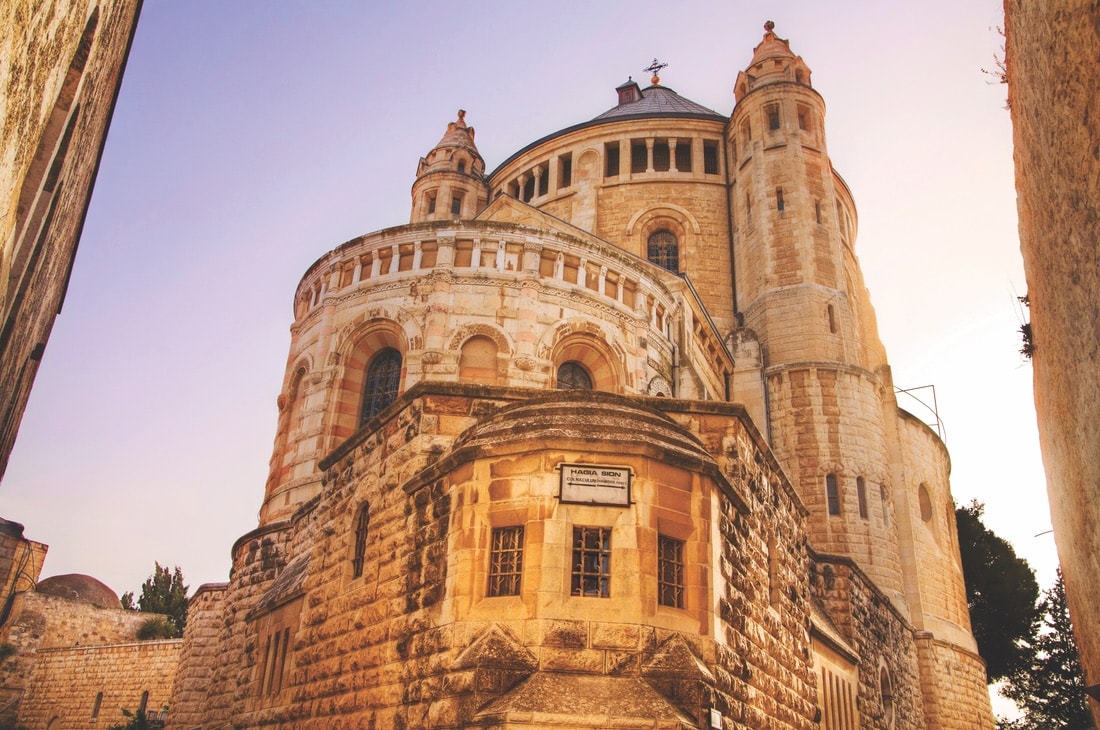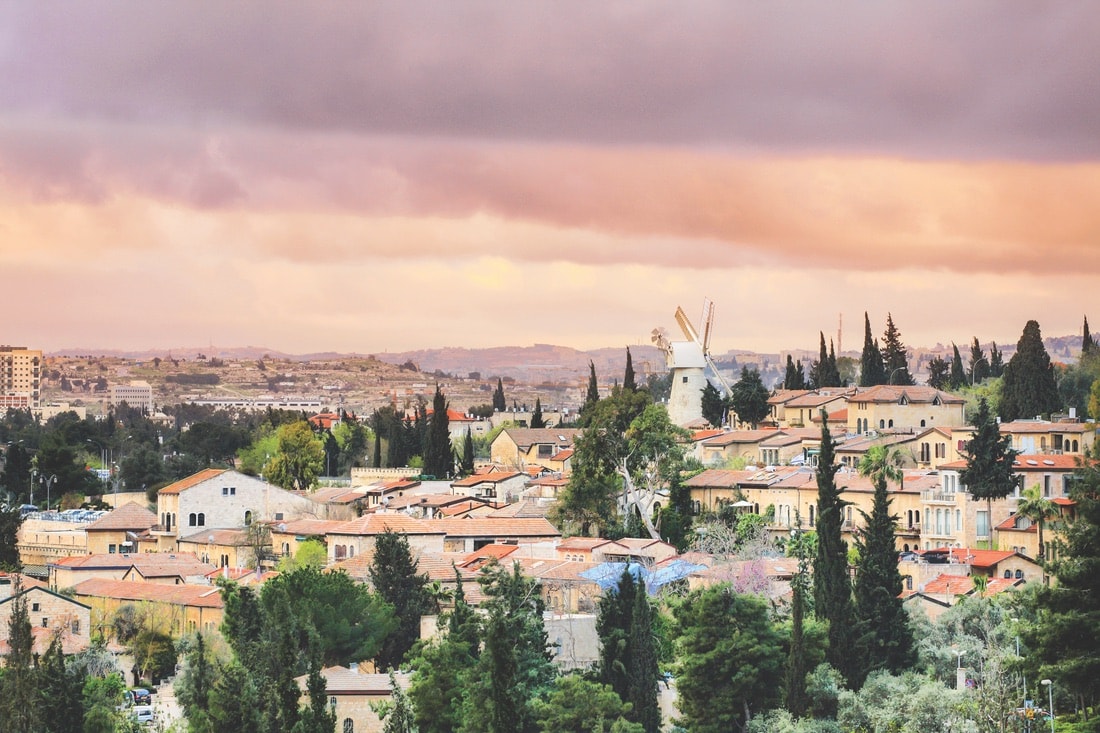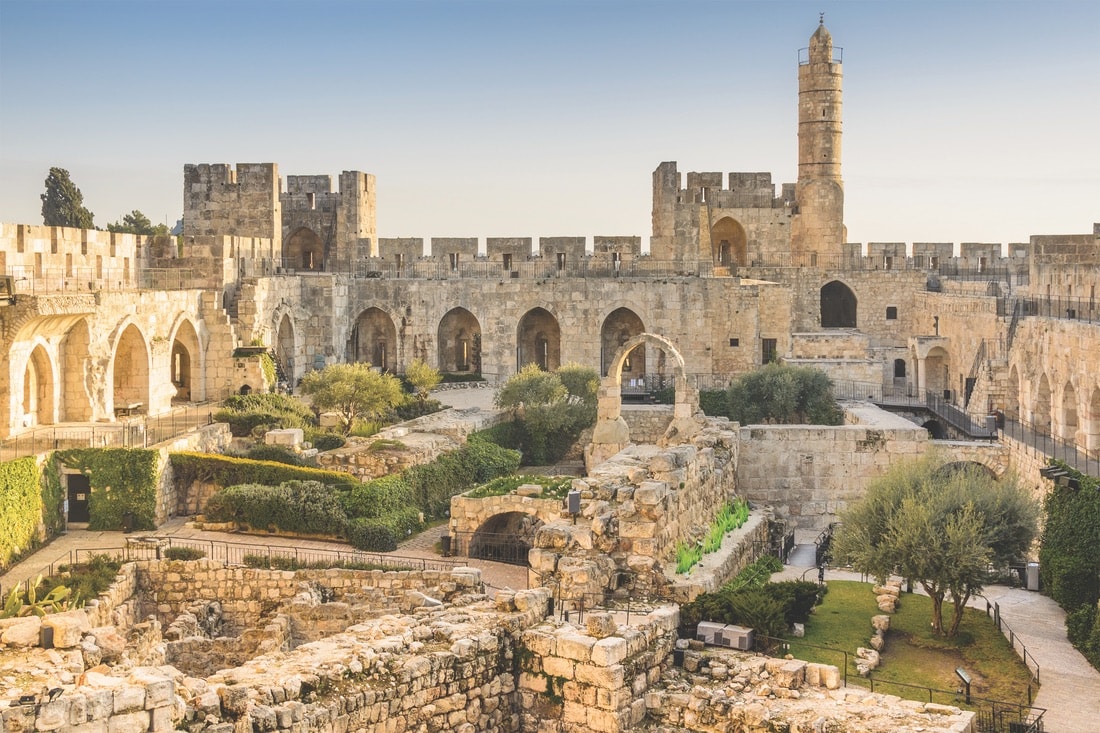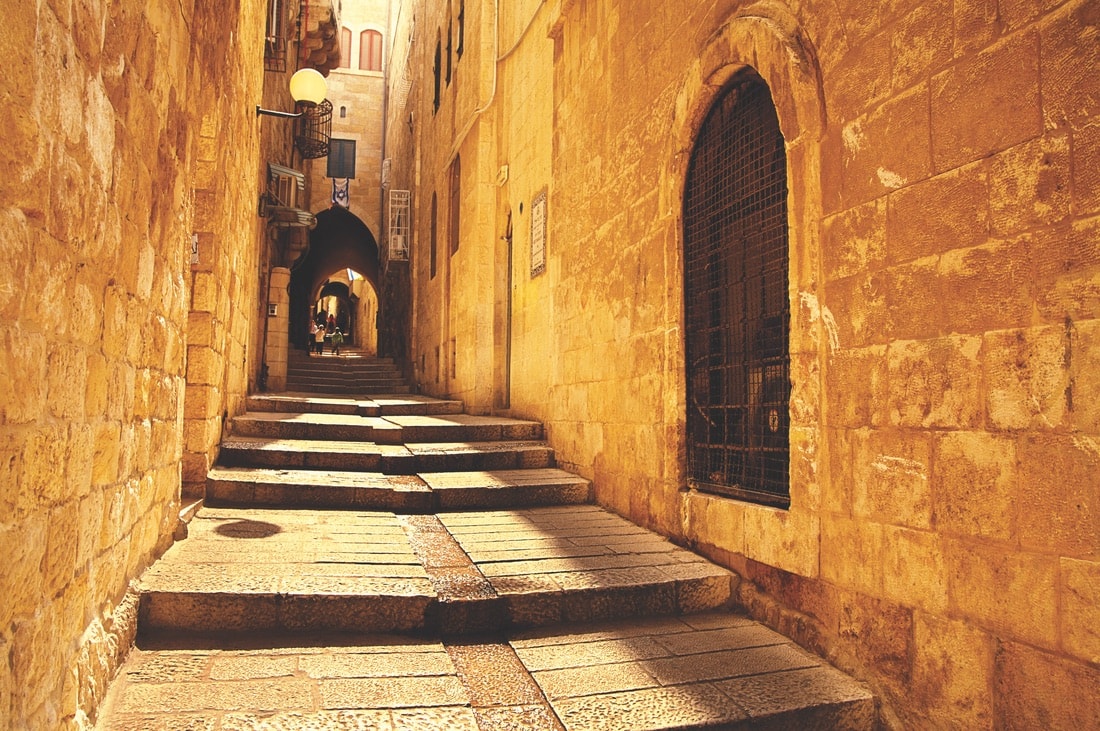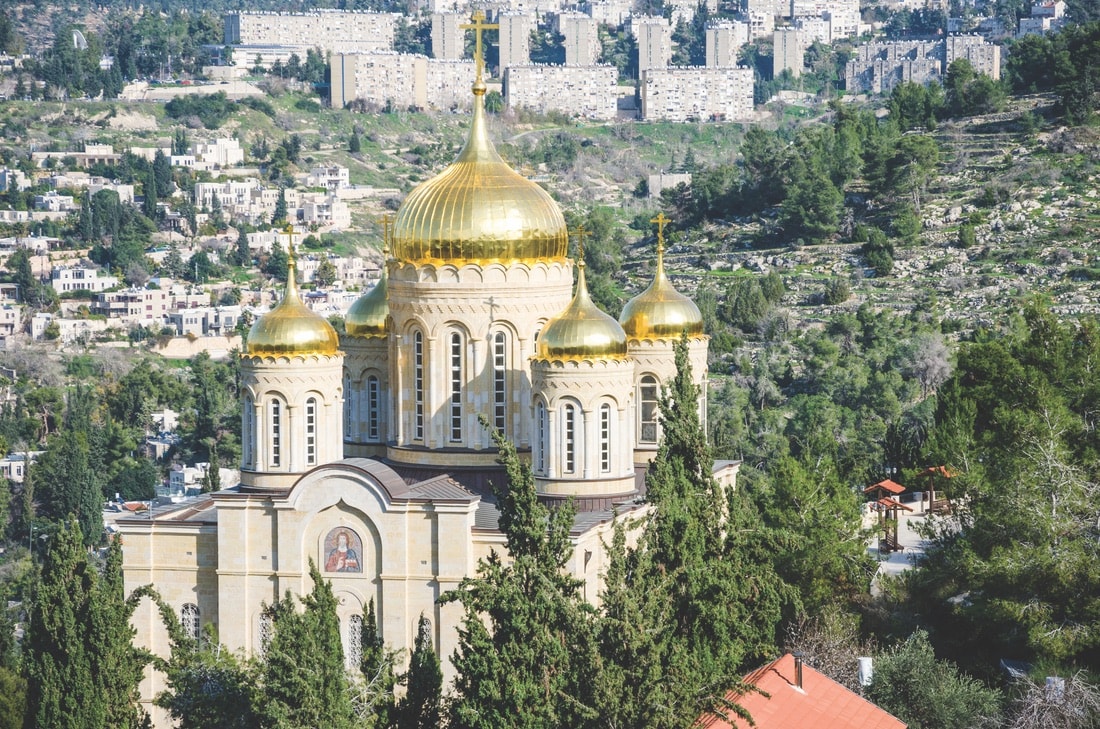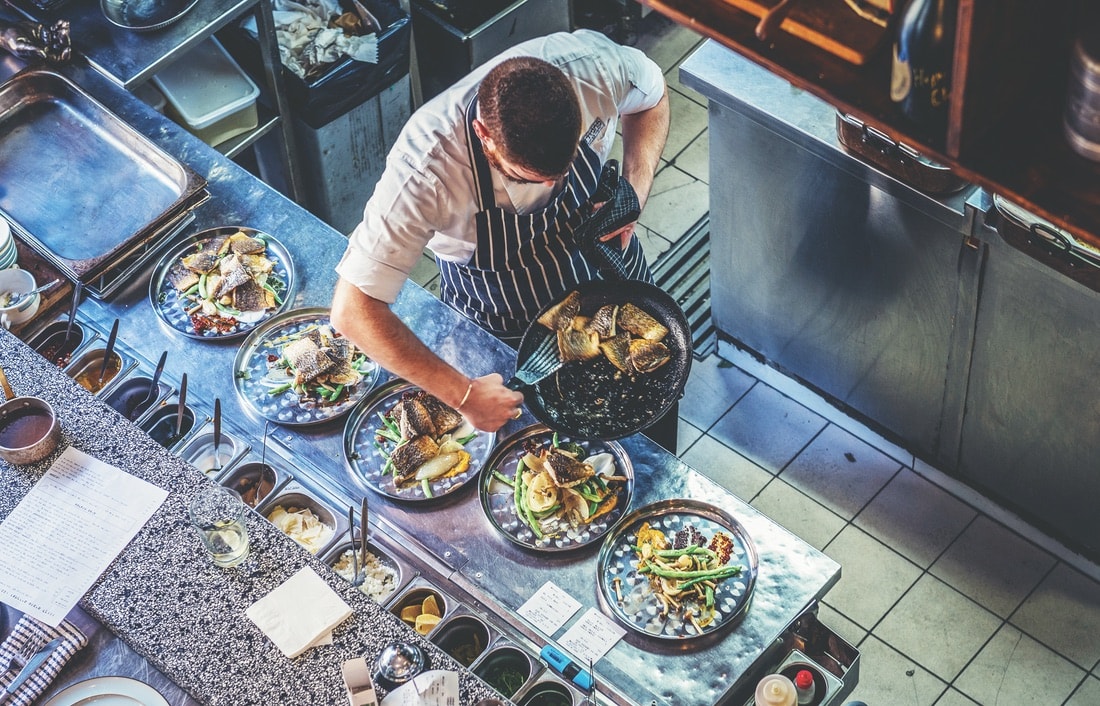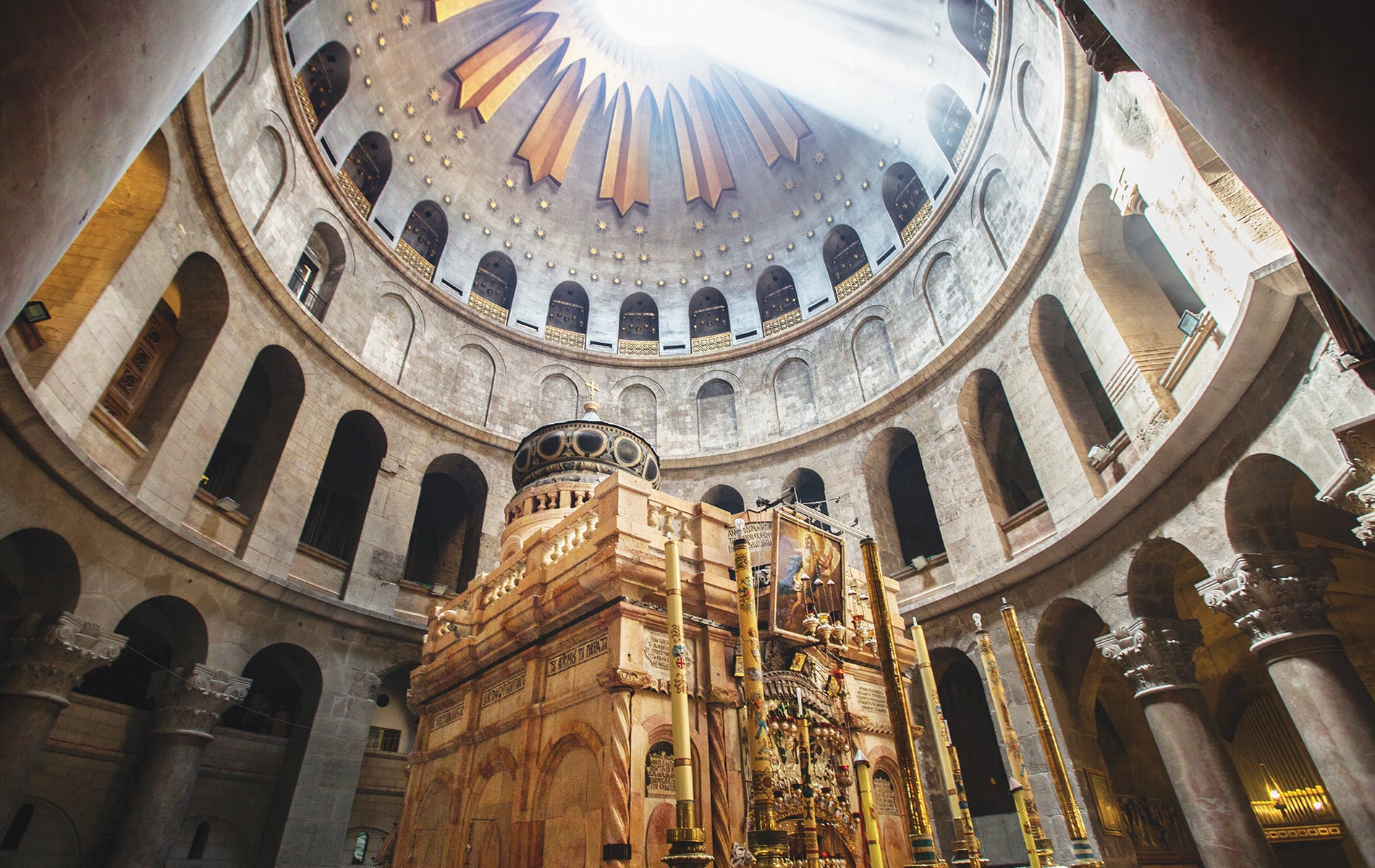
vie-magazine-jerusalem-hero-min
The majestic domed ceiling over Christ’s grave in the Church of the Holy Sepulchre. | Photo by Pavel Cheskidov / Shutterstock
The Eternal City
Jerusalem’s Wonder Knows No Bounds
By Anthea Gerrie
From the large corner window in my hilltop hotel room, I gazed out at a panorama almost too breathtaking to behold. On one side, an ancient golden-stone city of gleaming domes and spires climbed from a verdant valley; on the other, a pastel patchwork of barren hills stretched miles into the distance toward the Dead Sea.
“That’s the Mount of Olives, and over there is the Garden of Gethsemane,” said the bellman, gesturing toward the city. “And this,” he added as we turned to face those timeless, bleached-out hills devoid of any sign of life, “is the Judean Wilderness.” To say I was gobsmacked to find myself gawking at landmarks I had believed the stuff of biblical legend is an understatement.
No wonder Jerusalem Syndrome has been identified as a condition that strikes down many first-time visitors to the Eternal City. To arrive here is to feel you have stepped into the pages of the Bible, realizing perhaps for the first time that its locations not only exist but live on as part of the modern city. The reaction is profoundly emotional and makes several dozen visitors a year, according to Israel’s health ministry records, believe they have metamorphosed into Samson, King Solomon, or some other biblical personage.
- The Abbey of the Dormition on Mount Zion | Photo by Noam Chen / Israeli Ministry of Tourism
- Rooftops and windmill in Mishkenot Sha’ananim | Photo by Noam Chen / Israeli Ministry of Tourism
You never take Jerusalem for granted; the city takes your breath away every time you approach it. Jews, Christians, and Muslims alike consider it their holiest place. But over the decades, since I first laid eyes on Israel’s capital, I’ve come to realize there are many Jerusalems. There is the Old City with its holy places (and some distinctly secular retreats where you can escape the streams of pilgrims and other visitors), the modern metropolis with its buzzy market and restaurant scene, and the less-traveled neighborhoods surrounding the old Green Line that once divided west from east. That is where both Jewish and Arab residents are attempting to build bridges in a city that has survived millennia of repeated invasions.
An excellent place to start understanding Jerusalem’s rich and multilayered history is the Tower of David. This citadel, built two thousand years ago by Herod, tells the story of the city’s development over centuries of invasion by Assyrians, Babylonians, Persians, Romans, Byzantines, Arabs, Crusaders, Mamluks, and Ottomans, as well as the contributions the invaders brought with them. This engaging museum overlooking the ancient stones is even better at night, when a spectacular sound and light show conveys Jerusalem’s history. Intimate concerts of world music are also held here in early fall every year as part of the Jerusalem Season of Culture.
To arrive here is to feel you have stepped into the pages of the Bible, realizing perhaps for the first time that its locations not only exist but live on as part of the modern city.
The Season of Culture also offers a series of mind-opening journeys that allow participants to cross the Green Line and meet Arabs working for peace with like-minded Jews. Meytal Ofer created Dissolving Boundaries, a highlight of the festival, after her father, a former senior Israeli Army officer, was murdered by Arab terrorists. Through these meetings, Ofer hopes to convince both sides that violence is not a solution.
I learned about Ofer’s experiences over a meal with her at Satya, one of a new breed of sophisticated Jerusalem restaurants. The city was never a trendy dining destination until Machneyuda—a crazy, high-octane eatery named for the expansive market opposite it—changed everything a few years ago. Machneyuda is invariably packed but shouldn’t be missed, so book well ahead. Satya and others, including the fine-dining restaurants at the King David and Mamilla hotels, offer a calmer gourmet experience. The King David is a must-visit for the spectacular art deco interiors alone, but note it is also a place ingrained in the history of Israel. The hotel was formerly the headquarters of the British, the final foreign rulers before the country claimed independence.
- The Tower of David
- A gently sloping alley in the Jewish Quarter | Photo by Noam Chen / Israeli Ministry of Tourism
Today’s foreign emissaries tend to divide themselves between the King David and the atmospheric, if a little far-flung, American Colony hotel just across the Green Line. Jerusalem’s newest five-star hostelry is the much more contemporary Orient, which has put the quiet residential neighborhood known as the German Colony on the map. The hotel is opposite an old Ottoman-era railway station that is now an entertainment hub. Also a short walk from the station is the Mount Zion Hotel, which is more a four- than a five-star hotel but is suffused with period charm. Ask for a room in the old wing to get a spectacular view of the valley.
The Mount Zion and the King David are both within a leisurely stroll of the Old City, where Christians will want to explore the Church of the Holy Sepulchre and walk the Via Dolorosa. Here, even secular addresses are noted by their biblical location—Abu Shukri, famous for its hummus, is “just by the Fifth Station of the Cross,” while the Austrian Hospice isat Via Dolorosa 37. The latter’s café should not be missed for its excellent Viennese coffee, fantastic Sacher torte, and utter peace high above the city. The souk (marketplace), packed with every conceivable kind of religious souvenir, attracts crowds particularly on Saturdays, when regular shops close for the Jewish Sabbath.
- Moscovia Monastery in Jerusalem’s Ein Kerem village
- A chef at the trendy Machneyuda restaurant | Photo by Fotokon / Shutterstock
Saturday is also a great day to visit the Western Wall, where families come from all over the world to hold bar mitzvahs for their sons—mothers and other female relatives must peek over the wall dividing men and women in this strictly Orthodox outdoor temple. The Western Wall is the last remaining fragment of the Second Temple destroyed by the Romans. Above it sits the Dome of the Rock, a holy site for Muslims; only they are granted access to the heavily policed mosque.
Other must-sees include the Yad Vashem Holocaust memorial, the Israel Museum (home to the Dead Sea Scrolls, a fabulous art collection, and world-class relics of ancient civilizations), and the charming hillside neighborhood of Yemin Moshe with its famed windmill and artist colony.
There is much to see in the city’s outlying areas as well. The City of David with its archaeological sites, picturesque Ein Kerem (birthplace of John the Baptist), and the Judean Hills wine trail are all worth allowing extra days. The area now has a dedicated wine hotel, the Cramim, which gives tutored tastings of local wines, offers winery tours, and boasts an excellent spa that dispenses “vinotherapy.” Israeli wines are beginning to win top international prizes—check out the Burgundy-style chardonnay from Castel and the syrahs from Flam.
What goes around comes around—wine was first made in Jerusalem two millennia ago, and now, after centuries of repression by invaders and a further half century of conservatism under independence, the city is once again a joyous place of celebration, alive with wine, food, and song!
— V —
Anthea Gerrie is based in the UK but travels the world in search of stories. Her special interests are architecture and design, culture, food, and drink, as well as the best places to visit in the world’s great playgrounds. She is a regular contributor to the Daily Mail, the Independent, and Blueprint.
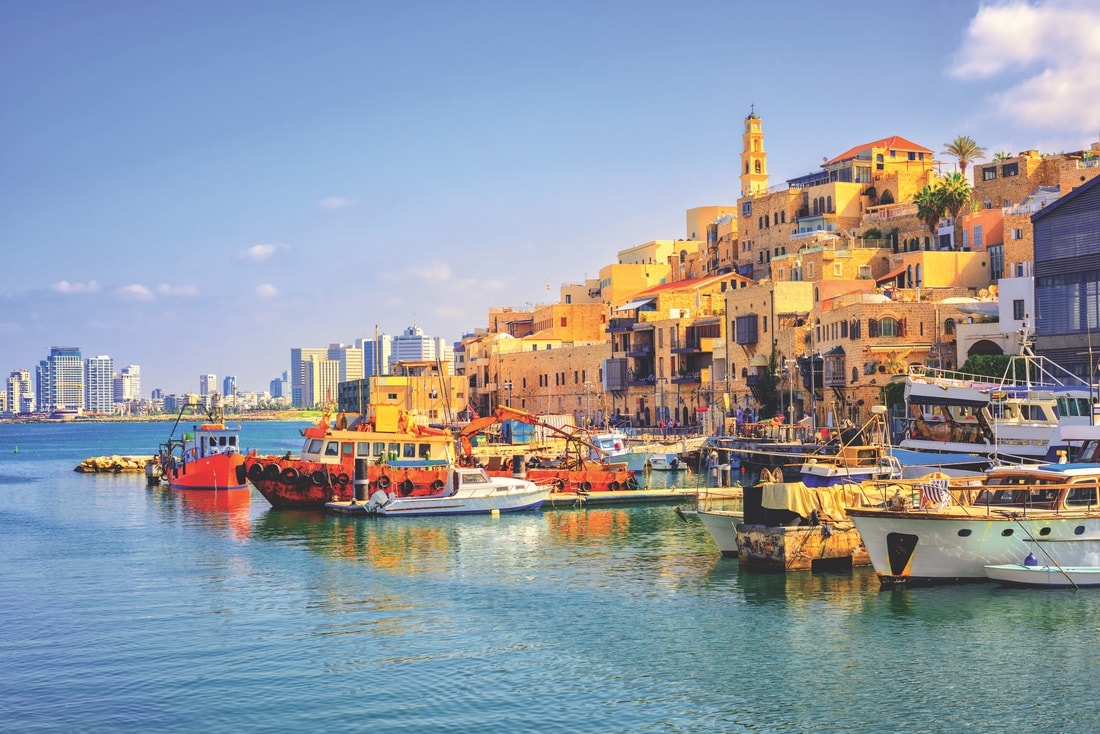
Tel Aviv’s colorful old town and port of Jaffa with the modern skyline in the distance
Tales of Tel Aviv
As Israel’s Ben Gurion Airport sits halfway between Jerusalem and Tel Aviv, it makes sense to spend a couple of days in Israel’s largest, most sophisticated, and most cosmopolitan city. Founded more than thirty years before independence, this city by the Med has evolved into one of the world’s great party towns and dining destinations.
Large family-oriented hotels line clean, sandy public beaches studded with bars and volleyball nets. The northern end near Tel Aviv Port offers more sophisticated waterfront dining. The southern beaches lead to the ancient town of Jaffa, which remains a warren of narrow alleys punctuated with cafés, art galleries, and a Friday flea market where Tel Avivers gear up for the weekend over brunch or a lazy late lunch.
Tel Aviv’s greatest charms lie inland along beautiful Rothschild Boulevard, an avenue so broad that its median strip forms a pedestrian park dotted with cafés, sushi bars, and summer sculptures. A new Independence Trail, mapped with an app, links many important heritage sites, and there are free weekly tours of the beautiful Bauhaus architecture, which has won UNESCO World Heritage Site status.
Sophisticates will love the Hotel Montefiore with its elegant rooms and fine food, and design buffs will enjoy Karim Rashid’s out-there Poli House, while the Royal Beach is the best of the beach hostelries. It lies just steps from buzzy Neve Tzedek, the hip neighborhood where Rothschild Boulevard begins.
Restaurants not to be missed include celeb haunt Taizu near the city center, Kitchen Market overlooking the Mediterranean in the Port area, and Manta Ray, perhaps the world’s most beautiful and atmospheric beach restaurant. The Royal Beach’s West Side restaurant offers inventive hotel dining.
Share This Story!
KEEP UP WITH THE LATEST STORIES FROM VIE



